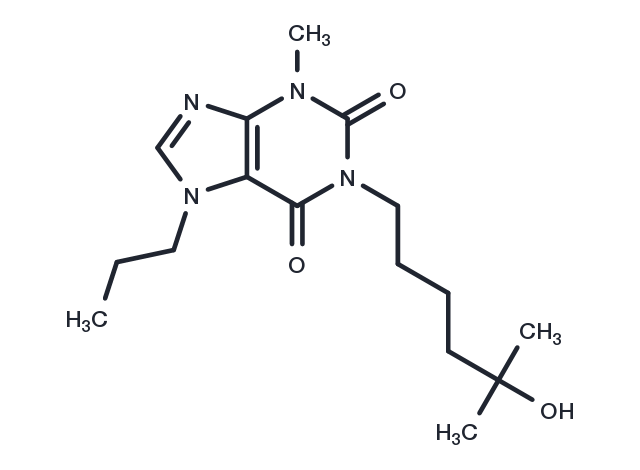store at low temperature
Powder: -20°C for 3 years | In solvent: -80°C for 1 year

A-802715 is a novel methylxanthine derivative that decreases the endogenous formation and blood levels of pro-inflammatory substances and increases the formation and blood levels of anti-inflammatory substances such as interleukin 10 receptor and tumor necrosis factor receptor.

| Pack Size | Availability | Price/USD | Quantity |
|---|---|---|---|
| 2 mg | In stock | $ 290.00 | |
| 5 mg | In stock | $ 397.00 | |
| 10 mg | In stock | $ 677.00 | |
| 25 mg | In stock | $ 1,290.00 | |
| 50 mg | In stock | $ 1,770.00 | |
| 1 mL * 10 mM (in DMSO) | In stock | $ 278.00 |

| Description | A-802715 is a novel methylxanthine derivative that decreases the endogenous formation and blood levels of pro-inflammatory substances and increases the formation and blood levels of anti-inflammatory substances such as interleukin 10 receptor and tumor necrosis factor receptor. |
| In vitro | The toxicity of the methylxanthine derivative A802715 is determined against the two human melanoma lines, Be11 and MeWo, and against the two human squamous cell carcinoma lines, 4197 and 4451, by vital dye staining assay. A802715, with a TD50 of 0.9-1.1 mM, is the most toxic. BrdU incorporations in p53 wt cells show that A802715 strongly enhances the irradiation-induced suppression of S-phase entry. Depending on the p53 status of the cell line, A802715 either prolongs the G2/M block or remains ineffective[1]. |
| Molecular Weight | 322.4 |
| Formula | C16H26N4O3 |
| CAS No. | 107767-58-8 |
store at low temperature
Powder: -20°C for 3 years | In solvent: -80°C for 1 year
DMSO: 60 mg/mL (186.10 mM), Sonication is recommended.
You can also refer to dose conversion for different animals. More
bottom
Please see Inhibitor Handling Instructions for more frequently ask questions. Topics include: how to prepare stock solutions, how to store products, and cautions on cell-based assays & animal experiments, etc.
A-802715 107767-58-8 Immunology/Inflammation IL Receptor A 802715 A802715 inhibitor inhibit
